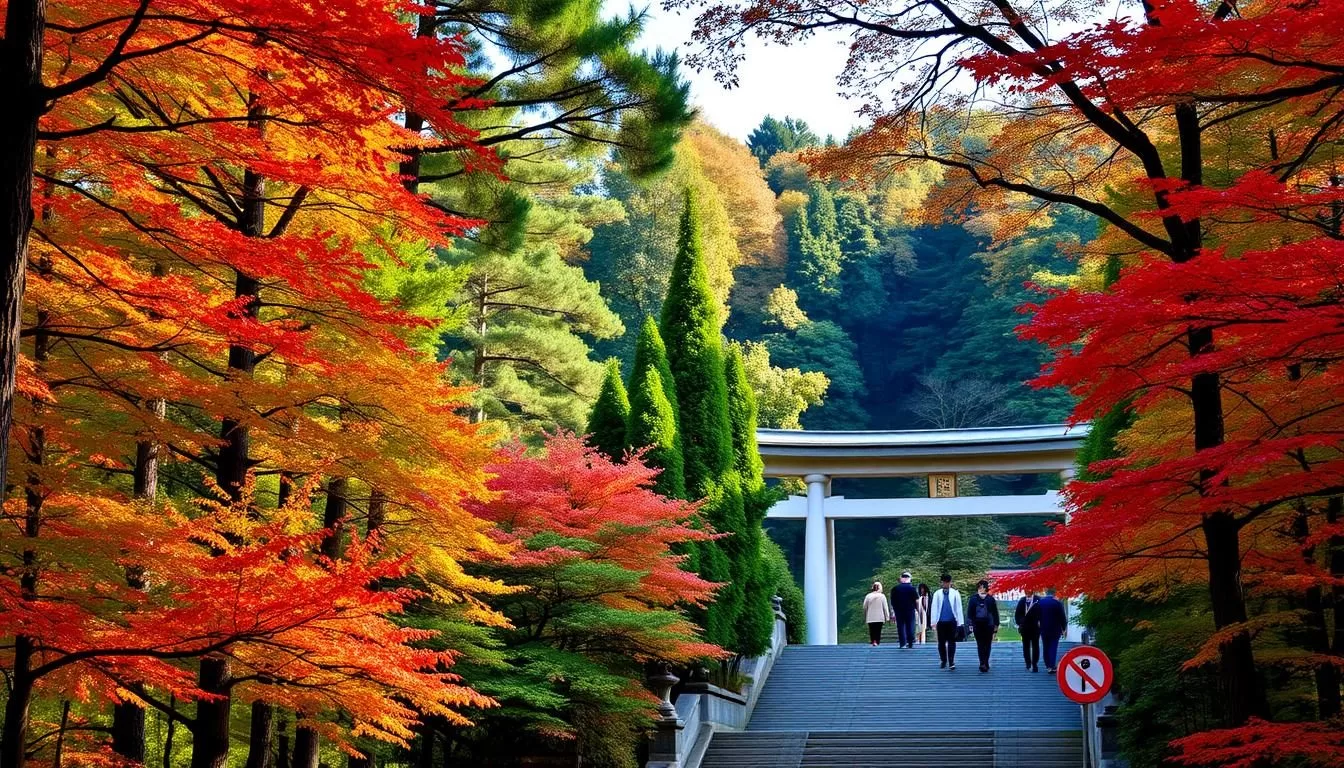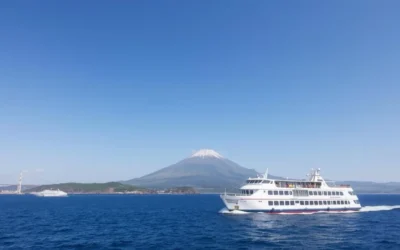✓ Accommodations✓ Flights✓ Rental Cars✓ Tours & Activities
Discover the Serenity of Meiji Shrine
Located beside the bustling Harajuku Station, Meiji Shrine offers a tranquil escape from Tokyo’s urban landscape. This serene Shinto shrine, dedicated to the deified spirits of Emperor Meiji and his consort, Empress Shoken, is a must-visit destination for travelers to Japan.
Meiji Shrine (明治神宮, Meiji Jingū) is one of Tokyo’s most significant spiritual landmarks. The shrine and the adjacent Yoyogi Park form a large forested area within the city, offering walking paths for a relaxing stroll away from the concrete jungle.
Welcome to our comprehensive guide to Meiji Shrine (Meiji Jingu). In this visitor guide, you’ll discover everything you need to know about visiting this historic shrine, from practical information to cultural insights. We’ll walk you through the shrine’s fascinating history, how to get there, opening hours, the various areas to explore, and the spiritual significance of this beloved landmark.
Whether you’re planning your first visit to Tokyo or returning to experience more of Japan’s rich cultural heritage, this guide will help you make the most of your time at Meiji Shrine.
The Sacred Forest in the Heart of Tokyo
Meiji Jingu’s tranquil forest, comprising around 100,000 trees from across Japan, provides a serene atmosphere that belies its urban location. The approximately 100,000 trees that make up Meiji Jingu’s forest were planted during the shrine’s construction and were donated from regions across the entire country.
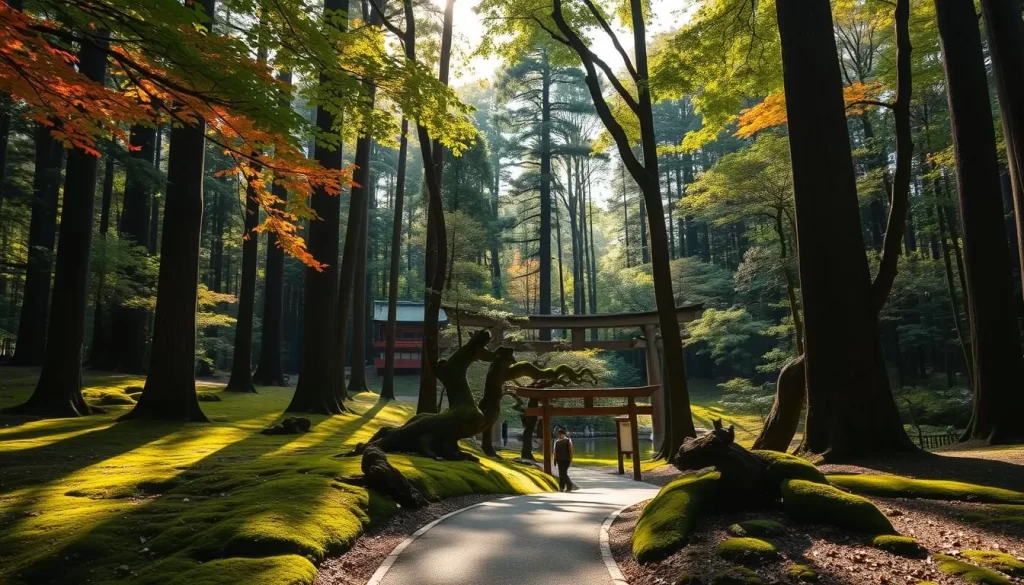
As you walk through the torii gate marking the beginning of the shrine grounds, you’ll find it hard to believe you’re in the middle of one of the world’s busiest cities. This tranquil, manmade forest covers a gamut of different species, creating a stark and refreshing contrast to Tokyo’s concrete landscape.
- Meiji Jingu stands as a remarkable green oasis in one of the world’s most densely populated urban areas.
- The shrine is surrounded by a lush forest that spans 170 hectares, making it one of the largest green spaces in central Tokyo.
- The forest serves as a natural buffer between the busy city and the sacred shrine grounds.
The forest’s unique characteristics and the peaceful ambiance it creates make Meiji Jingu a special location within the city, providing a fitting natural environment for honoring Emperor Meiji and Empress Shoken.
History of Meiji Shrine
The Meiji Shrine, a serene oasis in the heart of Tokyo, has a rich history dating back to its completion in 1920. It was dedicated to the deified spirits of Emperor Meiji and his wife, Empress Shoken, symbolizing the reverence of the Japanese people for their imperial legacy.
Emperor Meiji and Empress Shoken
Emperor Meiji and Empress Shoken are revered figures in Japanese history. The emperor played a crucial role in modernizing Japan, while the empress was known for her charitable works. Their legacy continues to be celebrated at Meiji Shrine, where people from all over the world come to pay their respects. The shrine’s significance is a testament to the enduring impact of these two historical figures.
Construction and Reconstruction
The construction of Meiji Shrine began in 1915 and was completed in 1920, involving an enormous national effort. One of the most remarkable aspects was the planting of 100,000 trees donated from across Japan, creating a lush forest that has matured over the years. The original shrine was destroyed during World War II, but it was rebuilt between 1958 and 1967, largely through public donations, highlighting the shrine’s importance to the people. Today, the shrine stands surrounded by a tranquil forest, with many trees serving as a reminder of the nation’s commitment to preserving its cultural heritage.
Getting to Meiji Shrine
Getting to Meiji Shrine is straightforward, with multiple metro lines and stations nearby. You can easily plan your visit using Tokyo’s efficient public transportation system.
From Harajuku Station
From Harajuku Station, it’s a pleasant walk through Yoyogi Park to Meiji Shrine. Simply exit the JR Yamanote Line at Harajuku Station and follow the signs directing you to the shrine. The walk is approximately 5-7 minutes, offering a serene start to your visit.
From Meiji-Jingumae Station
Alternatively, you can take the Tokyo Metro Chiyoda or Fukutoshin lines to Meiji-Jingumae Station. Upon exiting, you’ll be greeted by the impressive wooden torii gate marking the southern entrance to Meiji Shrine. The station’s name, Meiji-Jingumae, translates to “in front of Meiji Shrine,” making it a convenient access point. You can enjoy a leisurely stroll to the shrine, taking in the surroundings.
| Station | Lines | Approximate Walking Time |
|---|---|---|
| Harajuku | JR Yamanote Line | 5-7 minutes |
| Meiji-Jingumae | Tokyo Metro Chiyoda, Fukutoshin | 10 minutes |
![]()
Opening Hours and Admission Fees
When planning your visit to Meiji Shrine, it’s essential to know the opening hours and admission fees to make the most of your trip. The shrine complex is divided into several areas, each with its own schedule and requirements.
Main Shrine Complex
The Main Shrine Complex is open 24 hours a day, allowing visitors to explore the shrine grounds at their convenience. This includes the main shrine buildings and the surrounding forested areas.
Meiji Jingu Museum
The Meiji Jingu Museum operates from 9:00 to 16:30, with admission ending 30 minutes before closing. It’s a great place to learn about the history and significance of Meiji Shrine.
Inner Garden
The Inner Garden, or Naien, is a special section of the shrine grounds that requires a separate admission fee of 500 yen. It operates from 9:00 to 16:30, with shorter hours from November to February. The garden is particularly famous for its iris blooms in mid-June, when it stays open longer.
| Area | Opening Hours | Admission Fee |
|---|---|---|
| Main Shrine Complex | 24 hours | Free |
| Meiji Jingu Museum | 9:00 to 16:30 | Included with shrine visit |
| Inner Garden | 9:00 to 16:30 (shorter in winter) | 500 yen |
The Meiji Shrine Forest Experience
The Meiji Shrine Forest Experience is a journey through a tranquil oasis in the heart of Tokyo. As you enter the shrine grounds, you’re immediately enveloped in a serene atmosphere, courtesy of the over 100,000 trees that surround you.
The 100,000 Trees
The Meiji Shrine is nestled within a lush forest comprising more than 100,000 trees, representing over 240 species. This verdant canopy not only provides a natural haven from the urban sprawl but also symbolizes the shrine’s connection to nature and the spiritual essence of Shintoism.
Walking Paths and Torii Gates
As you stroll along the gravel-covered paths, the crunch beneath your feet serves as a reminder of your journey into a sacred space. The path is marked by significant landmarks, including Japan’s largest wooden torii gate, standing 12 meters tall. This majestic gate signifies the transition from the secular world to the shrine grounds, inviting you to walk deeper into the serenity of the forest.
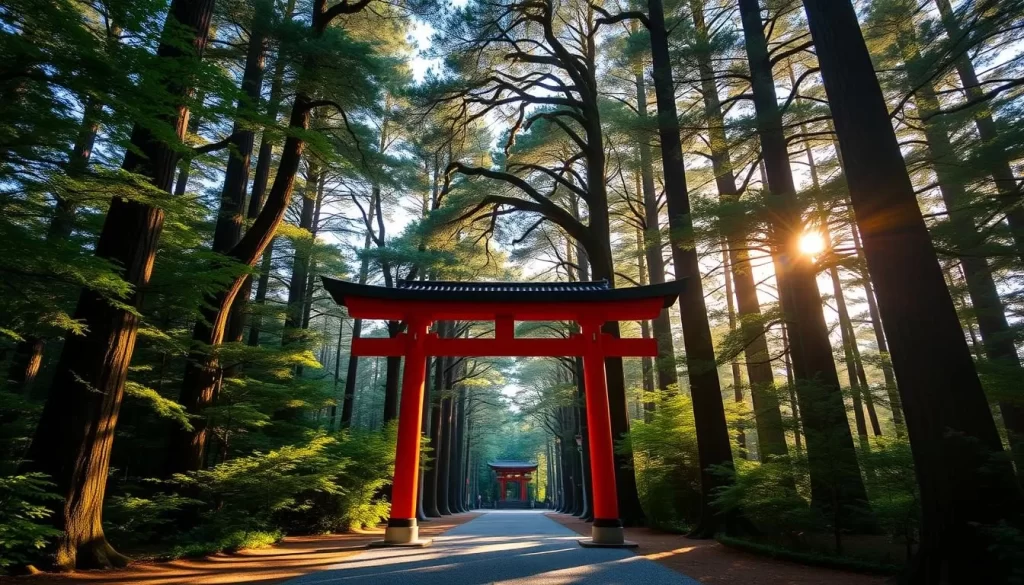
| Feature | Description |
|---|---|
| Tree Species | Over 240 species |
| Total Trees | More than 100,000 |
| Notable Landmark | Japan’s largest wooden torii gate |
Main Shrine Complex
The serene main shrine complex is the spiritual heart of Meiji Shrine, offering a peaceful escape from Tokyo’s urban landscape. As you explore this sacred space, you’ll discover a blend of traditional Japanese culture and spiritual practices that have been preserved for centuries.
Architecture and Design
The main shrine complex is renowned for its traditional Shinto architecture, characterized by the use of natural materials such as wood and stone. The design reflects a harmonious balance between the built environment and the surrounding lush forest, creating a tranquil atmosphere that invites contemplation and prayer.
Traditional Shinto Rituals
Visitors to Meiji Jingu can participate in various traditional Shinto rituals, including the purification ritual at the temizuya fountain and making offerings at the main hall. You can also write your wishes on ema (wooden prayer plaques) or purchase omamori (protective amulets) for specific purposes, such as health or academic success.
| Ritual/Activity | Description |
|---|---|
| Temizu | Purification ritual performed at the temizuya fountain |
| Offering | Making offerings at the main hall |
| Ema | Writing wishes on wooden prayer plaques |
| Omamori | Purchase protective amulets for health, success, etc. |
Meiji Shrine, Tōkyō, Japan: Visitor Information You Need to Know
As you plan your visit to Meiji Shrine, understanding the best times to visit and cultural etiquette can enhance your experience. Meiji Shrine is a serene escape in the heart of Tokyo, offering a unique blend of nature and culture.
Best Times to Visit
Visiting Meiji Shrine can be enjoyed throughout the year, but certain times are more favorable. The shrine is particularly beautiful during cherry blossom season in spring and the autumn foliage. Weekdays are generally less crowded than weekends, making them ideal for a more peaceful visit.
Etiquette and Customs
When visiting Meiji Shrine, it’s crucial to respect local customs. As visitors, you should bow when passing through torii gates and follow the temizu purification ritual. Dress modestly and maintain a respectful volume. When making offerings, follow the traditional sequence: bow twice, clap twice, pray, then bow once more. This shrine is an active place of worship, so be mindful of your behavior.
| Etiquette Tips | Description |
|---|---|
| Bowing at Torii Gates | Show respect by bowing when passing through |
| Temizu Ritual | Purify your hands and mouth before approaching the main hall |
| Dress Code | Dress modestly as a sign of respect |
The Inner Garden
Tucked away within Meiji Shrine is the Inner Garden, a place of natural beauty and spiritual significance. This serene area provides a tranquil escape from the hustle and bustle of Tokyo, inviting visitors to reflect and rejuvenate.
Seasonal Highlights
The Inner Garden is a treat throughout the year, with each season bringing its unique charm. In spring, the garden is adorned with blooming flowers, while autumn brings vibrant foliage. Visitors can enjoy the serene landscapes and appreciate the changing beauty of nature.
Kiyomasa’s Well: A Spiritual “Power Spot”
One of the Inner Garden’s most significant attractions is Kiyomasa’s Well, a historic spot believed to emanate spiritual energy. This well, dug by feudal lord Kato Kiyomasa around 400 years ago, has become a popular destination for those seeking good fortune and healing. Emperor Meiji himself visited this well, creating a profound connection between the shrine and this sacred place. Visitors often line up to place their hands near the water, absorbing the positive energy believed to emanate from Kiyomasa Well.
The Meiji Jingu Museum
Designed by the renowned architect Kuma Kengo, the Meiji Jingu Museum showcases an impressive collection of Meiji-era relics. The museum is a significant cultural institution within the Meiji Shrine grounds, offering visitors a deeper understanding of Japan’s history and the legacy of Emperor Meiji and Empress Shoken.
Personal Belongings of Emperor Meiji
The museum displays fascinating personal belongings of Emperor Meiji, including the carriage he rode to the formal declaration of the Meiji Constitution in 1889. These artifacts provide a unique insight into the life and times of the emperor, enriching your cultural experiences.
Special Exhibitions
Beyond its permanent collection, the Meiji Jingu Museum hosts rotating special exhibitions that explore different aspects of Meiji Empress Shoken‘s legacy and Japanese culture during the Meiji period. These exhibitions often include items rarely displayed to the public, sometimes on loan from other museums or imperial collections, further enhancing your visit.
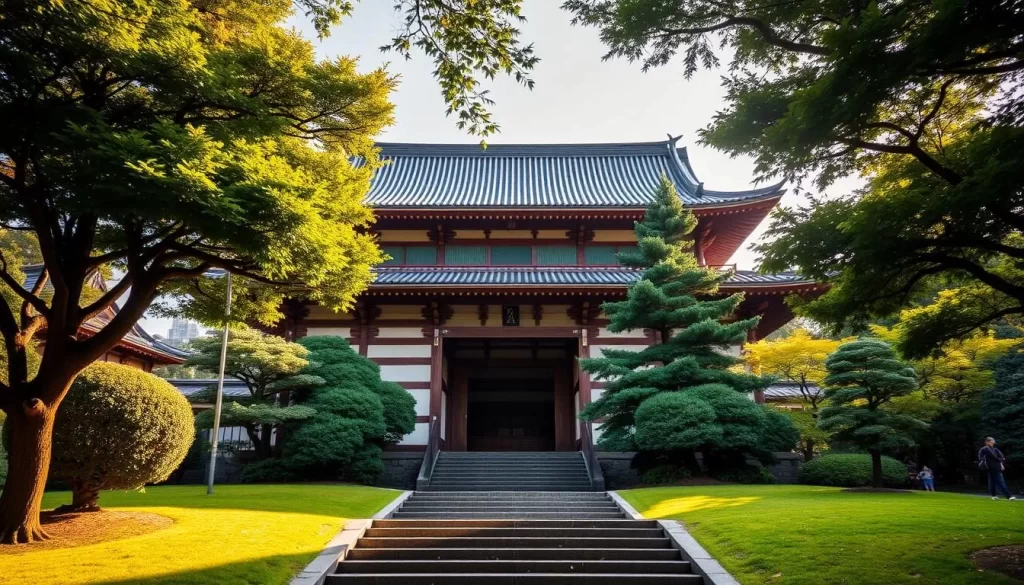
Witnessing Traditional Shinto Weddings
One of the unique experiences at Meiji Jingu is witnessing a traditional Shinto wedding ceremony. These weddings are particularly common on weekend mornings, offering visitors a memorable glimpse into Japan’s cultural heritage. The brides wear stunning white kimono, known as shiromuku, and elaborate headdresses called tsunokakushi, while grooms don formal montsuki hakama.
- The wedding processions move from the shrine’s main complex to the adjoining wedding hall.
- These ceremonies are led by shrine maidens and Shinto priests.
- Meiji Jingu performs more traditional Shinto weddings than almost any other shrine in Japan.
Visitors can observe from a respectful distance, and while photography is generally permitted, it’s crucial not to interfere with the ceremony.
Seasonal Events and Festivals
If you’re planning to visit Meiji Shrine, timing your trip around its seasonal events and festivals can enhance your experience. The shrine hosts various significant celebrations throughout the year, offering visitors a deeper connection to Japanese culture and spirituality.
New Year Celebrations (Hatsumode)
The New Year (Hatsumode) is one of the busiest times at Meiji Shrine, with millions visiting to pray for good luck, health, and happiness in the coming year. It’s a unique experience that showcases the shrine’s importance in Japanese culture. The atmosphere is filled with a sense of renewal and hope.
Spring Grand Festival
The Spring Grand Festival, or Shunki Reitaisai, is a highlight of Meiji Shrine’s annual calendar. Held from late April to early May, it commemorates Emperor Meiji’s birthday with rare performances of ancient court music and dance. This multi-day festival features traditional gagaku and bugaku performances, special Shinto rituals, and the display of treasures not normally shown to the public.
| Event | Date | Highlights |
|---|---|---|
| New Year Celebrations (Hatsumode) | January 1st | Prayers for good luck, health, and happiness |
| Spring Grand Festival (Shunki Reitaisai) | Late April to early May | Gagaku and bugaku performances, special Shinto rituals, display of treasures |
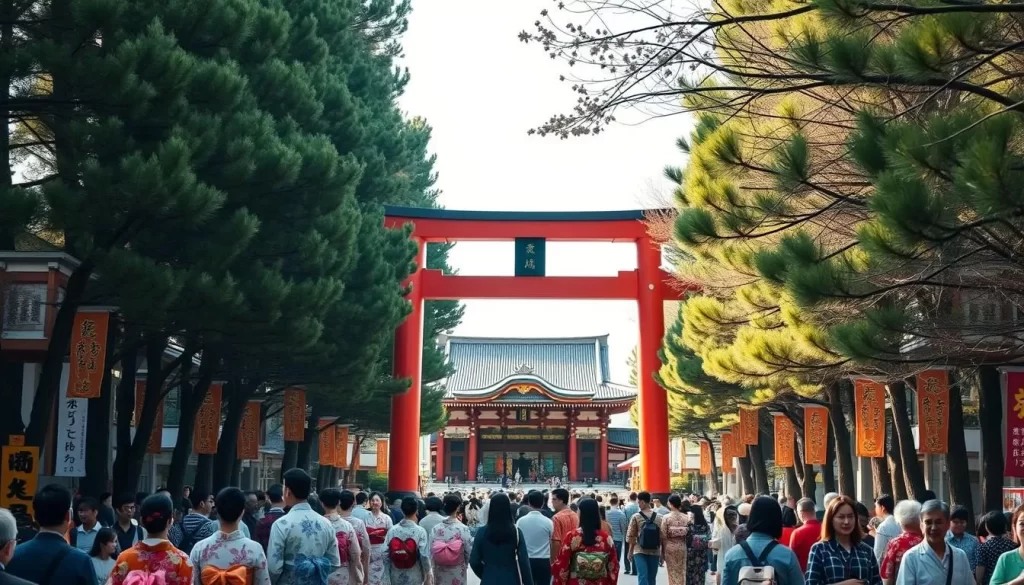
Combining Your Visit with Nearby Attractions
Once you’ve experienced the tranquility of Meiji Shrine, the surrounding areas await your discovery. The shrine is conveniently located near several popular destinations that offer a contrast to its serene atmosphere.
Yoyogi Park
Adjacent to Meiji Shrine is Yoyogi Park, a beautiful green space that is especially famous for its cherry blossoms in spring. You can stroll through the park, enjoying the natural beauty and perhaps stopping at one of the many food stalls or cafes nearby.
Harajuku and Omotesando
Just a short walk from Meiji Shrine’s southern entrance is Harajuku, known for its youthful energy, trendy fashion, and street culture. You can explore Takeshita Street, visit unique boutiques, and enjoy local snacks. Moving towards Omotesando, you’ll find upscale boutiques, sophisticated cafes, and architectural landmarks, earning it the nickname “Tokyo’s Champs-Élysées.” The area is a hub for culture and design, with buildings by renowned architects like Tadao Ando and Toyo Ito.
| Attraction | Description | Distance from Meiji Shrine |
|---|---|---|
| Yoyogi Park | A large park known for its cherry blossoms and natural beauty | Adjacent |
| Harajuku | Famous for its youth culture, fashion, and street food | Short walk |
| Omotesando | Upscale shopping street with modern architecture | Short walk |
Photography Tips for Meiji Shrine
Capturing the essence of Meiji Shrine through your lens requires an understanding of its unique environment. The shrine’s forest setting creates distinctive lighting conditions that change dramatically throughout the day and seasons.
Early morning offers the best photography conditions, when angled sunlight filters through the trees creating atmospheric rays, and mist sometimes lingers among the trees. The massive torii gates at the shrine entrances provide iconic photo opportunities, particularly the southern entrance near Harajuku.
To be a respectful photographer, avoid taking photos of people engaged in prayer without permission, and be aware that some ceremonies and interior spaces prohibit photography entirely. As a guide to capturing the shrine’s beauty, consider the seasonal highlights: spring brings cherry blossoms, summer offers lush greenery, autumn delivers colorful foliage, and winter sometimes brings magical snowfall.
Conclusion: The Timeless Tranquility of Meiji Shrine
In the midst of Tokyo’s vibrant landscape, Meiji Jingu offers a peaceful retreat, celebrating the legacy of Emperor Meiji and Empress Shoken. This serene shrine, nestled within a lush forest, stands as a testament to Japan’s ability to honor its traditions while embracing modernity.
As your guide to this sacred site, we’ve explored the various facets that make Meiji Shrine a must-visit destination. From its historical significance to its tranquil atmosphere, Meiji Jingu is a haven for both locals and international visitors seeking moments of peace and reflection.
The shrine’s remarkable environmental achievement, a man-made forest matured into a self-sustaining ecosystem, further enhances its appeal. As you plan your Tokyo itinerary, ensure that Meiji Shrine is on your list, offering a unique blend of spirituality, history, and natural beauty.
The above is subject to change.
Check back often to TRAVEL.COM for the latest travel tips and deals.
